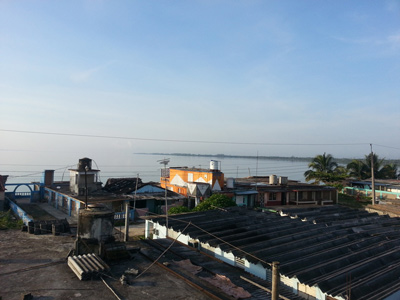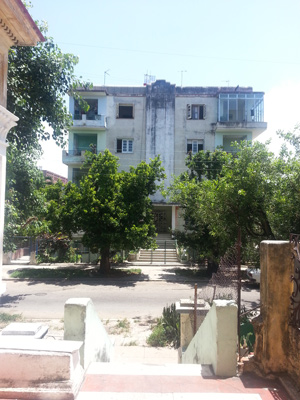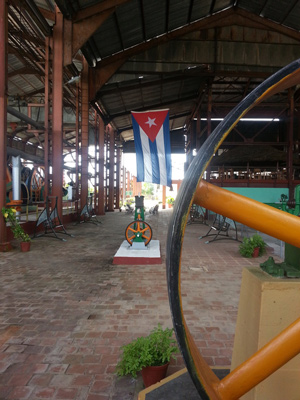Cuba Earning from Education
Graham Sowa
 HAVANA TIMES — When the history of how Cuba entered the globalized marketplace is written healthcare will be the principal protagonist. From exporting doctors to pay for Venezuelan oil and the Brazilian financed international super port at Mariel to entering the international medical education marketplace and the dynamic use of human resources in healthcare has become the most globalized feature of the Cuban economy.
HAVANA TIMES — When the history of how Cuba entered the globalized marketplace is written healthcare will be the principal protagonist. From exporting doctors to pay for Venezuelan oil and the Brazilian financed international super port at Mariel to entering the international medical education marketplace and the dynamic use of human resources in healthcare has become the most globalized feature of the Cuban economy.
When I arrived to Cuba there were very few medical students who paid to study here. Education, room, and board were paid for by the Cuban state.
All of that started changing in 2010. Soon after I arrived Raul Castro’s ministers began making economic changes to try to get more foreign currency income into government coffers.
It must have been during this time when the decision was made to make the medical education system into an income generating state enterprise.
The changes were evident to me by the shrinking numbers of new students sponsored by the Cuban government. The number of new students entering the Latin American School of Medicine on full scholarships fell by 50-60% a year from 2009 to 2012.
As new enrollment of Cuban state sponsored foreign students dwindled “auto-financed” students began showing up; mainly from a few African countries whose governments paid for student’s medical education directly to Cuba.
 After 12 years of providing over 10,000 free scholarships to medical students from 100 countries, including myself and almost 200 fellow US citizens, Cuba’s international medical education has moved quickly towards becoming an income driven state enterprise.
After 12 years of providing over 10,000 free scholarships to medical students from 100 countries, including myself and almost 200 fellow US citizens, Cuba’s international medical education has moved quickly towards becoming an income driven state enterprise.
For new students a 6-year medical school course costs around 80,000 CUC (about 90,000 USD).
A gamut of specialties is offered, from family medicine to radiology to surgery. Specializing in Cuba will set you back 15,000-20,000 CUC a year depending on the specialty and the quality of hospital you choose to study at (for example, institutions cost more than provincial hospitals).
Snake Oil Elixirs
At the conclusion of Cuban state biotech company Labiofam’s annual conference a few weeks ago the Scientific Council of the Las Villas Province Central University “Marta Abreu” published a resolution against the promotion of pseudoscience by Cuban institutions.
The authors wrote their resolution in defense of the scientific method and in support of rigorous scientific thought and investigation that has been promoted in Cuba since the Triumph of the Revolution.
Their claim is that the marketing of homeopathic therapies, such as Labiofam’s world famous Vidatox, undermine the very doctrines of evidence based medicine that the Cuban system is built upon.
They are right.
However, Labiofam has found that marketing watered down scorpion juice pays more bills than adhering to the basic tenants of science.
The economic success of Vidatox must have been noticed at the Finlay Institute, a Cuban state biotechnology and microbiology institute. Two weeks ago we received instruction to begin administering a “treatment” called TratHo to all patients with suspected cases of Dengue fever in the Salvador Allende Hospital.
 TratHo is a homeopathic “medicine” which, like most homeopathic products, is just a mixture of 70% water and 30% ethanol with some other compounds diluted down to undetectable, and completely inactive, concentrations.
TratHo is a homeopathic “medicine” which, like most homeopathic products, is just a mixture of 70% water and 30% ethanol with some other compounds diluted down to undetectable, and completely inactive, concentrations.
Why an Institute named after Dr. Carlos Finlay, whose extraordinary work made it possible to eradicate Yellow Fever from many countries, would resort to peddling pseudoscience is quite the contradiction.
However with the commercial success of other Cuban homeopathic “remedies” there is a desire to cash in rather than continue in the work started by the good Doctor Finlay.
Collecting Abroad
Even though the Cuban health system was on life support during the worst of the Special Period crisis of the 1990’s, it continued the training of a large healthcare workforce that gave Cuba the exportable labor surplus to participate in the globalized economy today.
While there exists a major humanitarian mission in the forefront of Cuba’s worldwide medical solidarity brigades, such as the recent commitment to fight Ebola in West Africa, the government of Cuba also receives payment, in cash or in-kind, for most of its overseas medical collaboration.
This income is essential to keeping the Cuban economy functioning, not only increasing resources for the Cuban state, but also allowing Cuban doctors to earn much more money than they earn in Cuba.
Healthcare workers returning from mission abroad bring capital into Cuba, an important part of increasing ordinary Cuban’s purchasing power without having to have an awkward discussion with Cuban workers about increasing their state salaries.
 This efflux of Cubans to work in foreign lands has created a demand for more healthcare workers, and the education sector is responding by drastically increasing enrolment numbers.
This efflux of Cubans to work in foreign lands has created a demand for more healthcare workers, and the education sector is responding by drastically increasing enrolment numbers.
This school year incoming medical student class sizes has grown by over 300% in some universities.
To entice more students toward medicine the grade point average required to enter a medical study course has been lowered, students are told they can probably work abroad after finishing their degree, and the obligatory 2-year military service has been eliminated for students studying medicine.
Globalization at Work
The Cuban sugar industry still has not recovered from its 25 year old collapse. Other industries, such as petroleum exploration and the port in Mariel are still struggling to get off the ground. Tourism continues to grow, but comes nowhere close to competing with other Gulf of Mexico/Caribbean markets such as the Bahamas, Dominican Republic and Cancun.
Medicine is the standout example of smart globalization by the Cuban state. Be it importing medical students, selling homeopathic remedies to naive upper-class consumers, or exporting medical personnel abroad these economic activities have proven capable of creating much need foreign currency income for the government as well as individual Cubans.
In light of this economic boon Cuban health services and education have taken on dynamic personalities absent in other, more stagnant, sectors of the Cuban economy. What remains to be seen is just how far this global economic triumph story will be allowed to change domestic Cuban policy.

Cuba is unable to grow sugar profitably. The productivity of Cuban farms is shrinking every year. The island’s infrastructure is crumbling for lack of repair. They don’t manufacture anything worth exporting.
Therefore it is prudent to ask: Are they really able to provide good quality training for so many doctors and nurses?
For a detailed look at all aspects of Cuban medical missions, read this article:
CUBA’S BUSINESS OF HUMANITARIANISM: THE MEDICAL MISSION IN HAITI
http://www.ascecuba.org/c/wp-content/uploads/2014/09/v21-werlau.pdf
While focusing on Haiti, the methods and purposes developed in Haiti are being applied elsewhere today. The missions to Venezuela and now Brazil are designed to bring in money to the regime, with a large dose of political prosylitization added. In Haiti, the Cuban government negotiated an arrangement with the Norwegian government in which Norway would send money to cover a large portion of the costs of the Cuban medical mission.
Now in Africa, it has been reported that the WHO is paying the costs of the Cuban medical teams being sent to fight Ebola. The medical workers themselves receive wages a fraction of the amount paid to Cuba, which is a violation of international labour laws which stipulate the workers must be paid directly by the host country or charitable agency.
Cuba is indeed “earning from education” by using Cuban doctors as “indentured / slave” labor and denying them all freedoms.
Cuba figured long ago that it could become a provider of medical care to other developing nations and even some industrialized nations. As state sponsored enterprises go, it is a very inexpensive one and the return on investment is very attractive. It costs about $15,000 to train a native Cuban specialist. The government earns five-six times that much in one year in revenue for their service abroad. For now, it remains a solid business model. From the time I went thru medical school, the curriculum has changed to accommodate new text material and some technology but the sequence and methodology remains the same. The program is as intense there as it is in any other country. The skill and reputation of those clinicians continue to earn the Cuban government currency and accolades.
The average Cuban, however, does not benefit much from the revenue that healthcare generates abroad. Local hospitals and clinics continue to lack equipment, material supplies and critical pharma for treating the most basic conditions. Other than word of mouth, most Cubans don’t know that the doctor next door brings the Cuban government a six figure income. He or she, however, only earns about 1-2% of that. Ironic, isn’t it?
Thank you Graham Sowa for an informative piece. If possible, could you post any information on the outcome of the “resolution against the promotion of pseudoscience by Cuban institutions.” It is vital and important to be able to discuss the issue of compromises inherent to both medical practice and political expediencies.
Despite using assembly-line trained doctors as chattel for export, the Cuban economy continues to spiral downward with an estimated growth for 2014 at less than 1% and food imports increasing to 80% of consumption. Wait….this sounds negative. The good news is that poor, medically-underserved peoples around the world will be treated by Cuban doctors where no other doctor was willing to work. See, I can be positive.
Thanks for your enlightening analysis of Cuban medical research and education. According to a German acquaintance who is knowledgable on such matters, apparently the same practices have been instituted by the Escuela Internactional de Cine y TV in San Antonio de los Banos, which also seeks to bring in foreign students, some with less qualification, but who are paying in hard currencies.
Regarding the efficacy of homeopathic “medicines,” this is a refletion of the connection between body and mind, and may show how diseases of the body may be affected by the mind and vice versa. One hundred and fifty years ago my own town of Brattleboro, Vermont, was the center of a famous “water cure;” thousands of upper-middle-class and wealthy women, many the wives of plantation owners from the South, traveled to my town to partake of the Drs. Wesselhoeft’s and Felerer’s cure. The Civil War put an end to that. Still, to this day, a series of unorthodox “cures” come-and-go with a perpetual, systolic, regularity. Hence, if the Cuban homeopathic “cures” produce results in some folks, and they are willing to pay, what’s the harm? This sort of stuff has been going on in medicine since the dawn of civilization. In George Elliott’s “Middlemarch,” an interesting dialectic between the different philosophies and styles of medicine popular in mid-19th Century England is described.